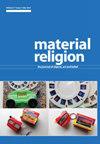Printing Infidelity: Watson Heston and the Making of the Impressionable Freethinking Subject, 1873–1900
IF 0.4
3区 哲学
0 RELIGION
引用次数: 0
Abstract
Abstract Nineteenth-century print media provided a set of metaphors with which American unbelievers began to articulate an understanding of religious infidelity as something permanent. Ink, paper, pencil, and mechanical printing technologies served as symbols for articulating disbelief as something imprinted indelibly on the mind of the reading or viewing subject. Thus, over the course of the nineteenth century, American nonbelievers began discussing infidelity less in terms of something rationally subscribed to and more in terms of something non-rationally imprinted at a young age. At the same time, the late nineteenth century witnessed an increasing emphasis on a militaristic understanding of missionary activity incumbent upon American infidels—a tendency partially enabled by understandings of the cartoon image as a tool suited to the defeat of believers and the creation of young unbelievers.印刷的虚幻性:华生·赫斯顿与可印象的自由思考主题的形成,1873–1900
摘要19世纪的印刷媒体提供了一系列隐喻,美国的不信教者开始用这些隐喻来表达对宗教不忠的理解,认为宗教不忠是永久性的。墨水、纸张、铅笔和机械印刷技术是表达怀疑的象征,因为怀疑是不可磨灭地印在阅读或观看对象脑海中的东西。因此,在19世纪的过程中,美国的非信徒开始讨论不忠——与其说是理性认同的东西,不如说是年轻时就被非理性印记的东西。与此同时,19世纪末,美国异教徒越来越重视对传教活动的军国主义理解——这一趋势在一定程度上是由于他们将卡通形象理解为一种适合击败信徒和创造年轻异教徒的工具。
本文章由计算机程序翻译,如有差异,请以英文原文为准。
求助全文
约1分钟内获得全文
求助全文

 求助内容:
求助内容: 应助结果提醒方式:
应助结果提醒方式:


